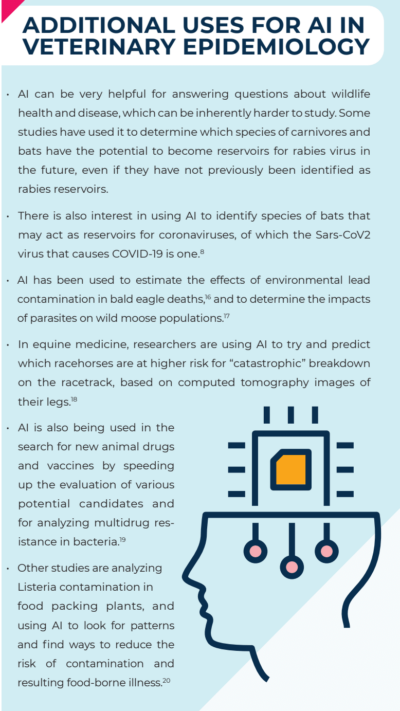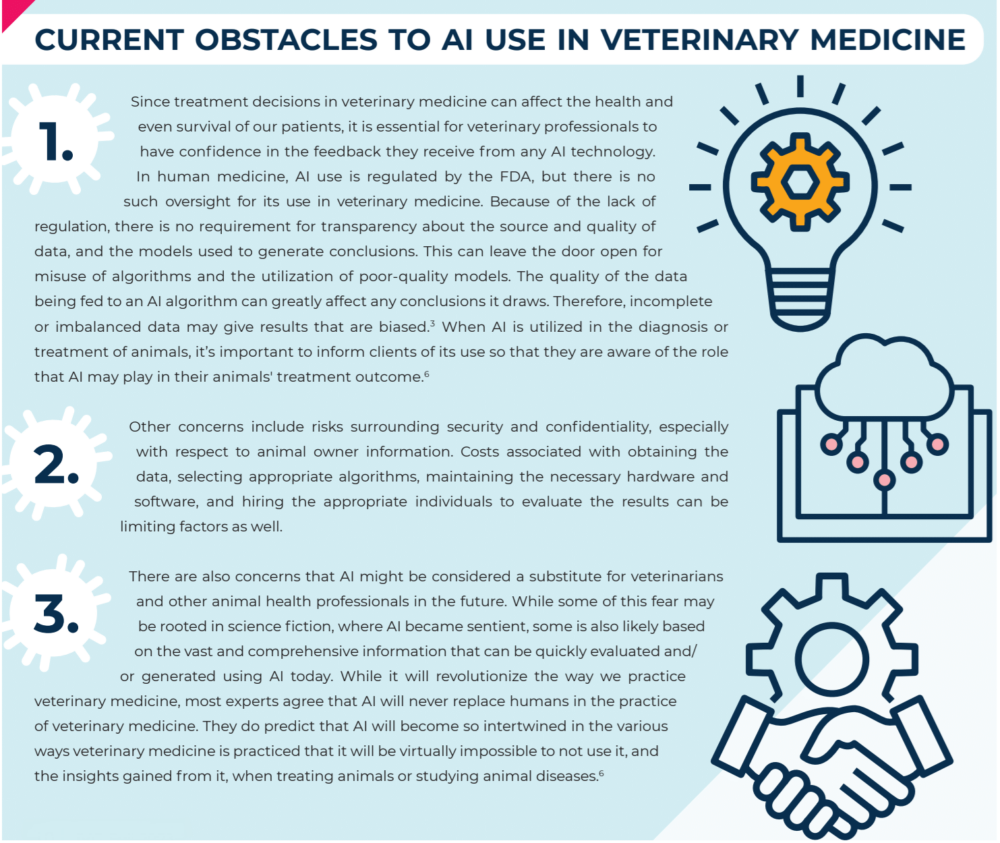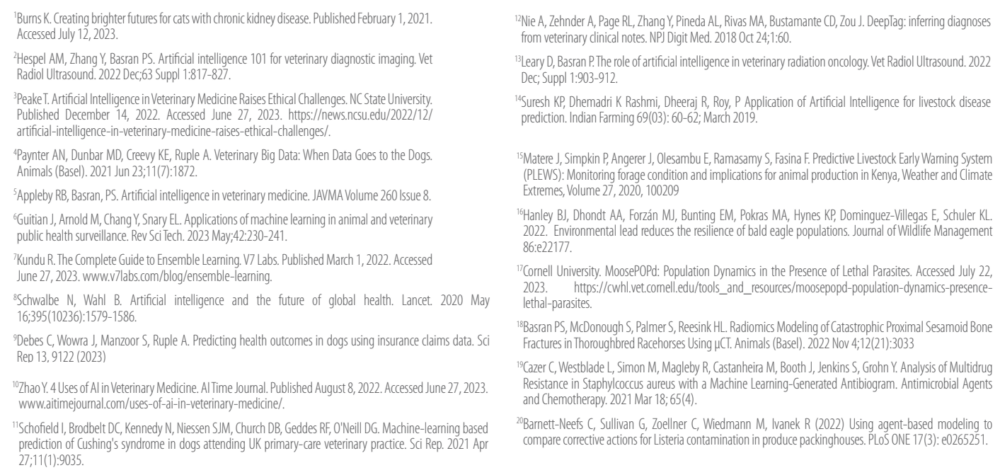Because of its potential for creating valuable insights into protecting animal health, artificial intelligence (AI) will be a big part of the future of veterinary medicine and epidemiology. This means experts in veterinary medicine, epidemiology, and AI will need to work together to ensure the technology is used responsibly and interpreted correctly.
Almost every facet of everyday life has been affected by artificial intelligence (AI), or will be in the near future. From autocorrect features on smart devices to photo editing apps and the increasingly popular ChatGPT, AI is transitioning from a poorly understood topic of science fiction stories to an integral feature of daily life. In many industries, AI has become an essential tool for improving workplace efficiency and advancing new discoveries. It has already started to leave its mark on the fields of veterinary medicine and animal health. In clinical practice, for example, AI is being used to predict the likelihood of renal disease in cats based on serial lab work results.1 AI-assisted radiographic interpretation, called radiomics, has been used in the analysis of digital radiographs and ultrasound images.2 And practitioners are touting ChatGPT as a productivity aid to speed the writing of their medical note templates. Apart from uses in clinical practice, AI has also become an increasingly effective tool in veterinary epidemiology, which is what this article will focus on.
AI AND BIG DATA
Veterinary epidemiology is defined as a study of the distribution and determinants of animal health-, welfare-, and production-related states or events.3 Veterinary epidemiology can be helpful in promoting health and well being at the level of the individual, the herd, and the community at large (both animal and human).
With the rise of big data in veterinary medicine, AI has become increasingly relevant and necessary. Big data is defined as large, hard-to-manage volumes of data both structured and unstructured that inundate business on a day-to-day basis.3 Veterinary big data can include animal demographics and lifespan, rates of death or disease, and other factors such as weather patterns, animal movement, and geography.3,4 Sources of veterinary big data include the Dog Aging Project, the Golden Retriever Lifetime Study, and the Veterinary Companion Animal Surveillance System (VetCompass), among many others.5 AI has the potential to unlock previously unknown insights from this data, to highlight areas where further study is needed, and predict future challenges.
AIs superiority over other forms of data analysis lies in its ability to consume data in large quantities, and draw conclusions from it, without a human having to direct every step the algorithm takes. These advantages can result in faster results, lower costs, and new insights into problems that were previously difficult or cumbersome to address. One form of commonly-used AI is machine learning (ML), defined as a subfield of AI in which algorithms are trained to perform tasks by learning patterns from data rather than by explicit programming.5,6 ML can be divided into several different categories depending on the type of data being used, how much is known about the data, and what the goals of the analysis are. Within these different types of ML are various models that can be used individually to evaluate the data.
quantities, and draw conclusions from it, without a human having to direct every step the algorithm takes. These advantages can result in faster results, lower costs, and new insights into problems that were previously difficult or cumbersome to address. One form of commonly-used AI is machine learning (ML), defined as a subfield of AI in which algorithms are trained to perform tasks by learning patterns from data rather than by explicit programming.5,6 ML can be divided into several different categories depending on the type of data being used, how much is known about the data, and what the goals of the analysis are. Within these different types of ML are various models that can be used individually to evaluate the data.
With ensemble learning, multiple models are used in synchrony to improve the accuracy and consistency of the results.7 Other forms of AI include data mining (searching through large amounts of data for patterns), natural language processing (AI algorithms that are trained to understand written and/or spoken text, such as in medical records), and signal processing (analysis of images, audio or video, and other types of information).5
The use of ML and other forms of AI can significantly improve our ability to diagnose disease, assess patient morbidity and mortality risk, predict and monitor disease outbreaks, and plan health policy in both human and animal health.8 Well now review some of the current and potential uses of AI in veterinary epidemiology, along with some of the obstacles that AI faces in becoming a more useful tool in veterinary medicine.
COMPANION ANIMAL MEDICINE
Fetch Pet Insurance recently reported their use of AI to analyze a pool of more than 750,000 insured dogs and 2.4 million claims collected from these dogs over 17 years. The data included breed, age, sex, geographical location, history of previous diseases, and any treatments the dogs received. Using ensemble ML, researchers were able to identify 45 disease groups whose risk of occurring in the next year can be predicted in individual dogs with a high degree of accuracy. These include 710 specific diseases (82.5% of the claims submitted). Examples of predicted conditions include arthritis, disc diseases, diabetes, thyroid disorders, adrenal gland disorders, and certain cancers. These ML models can be helpful for pet insurance companies to predict the risk of certain conditions, and therefore provide better preventative recommendations to help clients reduce the risk for their dogs. This data may also be useful for other research studies aimed at preventing and treating diseases in dogs.9
Studies have demonstrated the effectiveness of AI in identifying patients who should be tested for Addisons disease or Cushings syndrome.10,11 AI with natural language processing software has also been programmed to read medical records and codify them so they are easier to track and draw conclusions from in the future.12
For dogs with neoplasia, AI is helping researchers examine new ways to administer radiation therapy that results in less damage to healthy tissue. Following advances made in human radiation oncology, veterinary researchers are studying ways to use AI technology such as ML and deep learning (DL a specific type of ML), to clean up the noise on CT images used for planning radiation treatment in animals. AI technology is also being combined with information about genetic markers for cancer to more accurately and efficiently create radiation treatment plans with fewer toxic side effects to healthy tissue, a field known as radiogenomics.13

PRODUCTION ANIMAL MEDICINE
AI also has many uses for improving the health and production of livestock species. Since measures taken to treat livestock species are usually done at the herd level, AIs ability to process large amounts of data and incorporate multiple variables is ideal. AI algorithms have been constructed to consider weather patterns, movement of animals, and current disease incidence in a particular geographical location. These algorithms are then used to predict the risk of future disease in populations of animals, and help producers pinpoint which steps would be most appropriate to reduce the risk. One such study in India developed a disease-climate relationship model using AI and GIS (geographic information system) to predict 13 economically important livestock disease outbreaks.14
Early Warning Systems (EWS) can also be developed using AI and remote surveillance to detect changes in the environment that can negatively affect animal nutrition and health. This can include tracking drought conditions, measuring the amount of water present in a watering hole, and measuring and predicting the growth of vegetation upon which grazing animals depend for food.14,15
Other reported uses of AI include predicting lameness in dairy cows based on milk production and conformation traits; estimating the location, size, and type of poultry operations in the US using drone images; early detection of emerging animal diseases; and identifying predictive factors for farms becoming positive for bovine tuberculosis.9
In addition to disease prediction, AI is a useful tool for livestock disease surveillance in what would otherwise be a very labor-intensive and costly process. Instead of humans visiting or otherwise communicating with producers and recording information on animal population numbers, locations, and disease rates, drones and remote sensors can be used to capture images and other information that can be analyzed using AI-backed photo recognition software and other programs. This type of photo surveillance is also useful for detecting lesions in animals in slaughterhouses that can serve as sentinels of disease in the animal population.7
As we continue to use AI more and more in veterinary medicine, it will be essential to maintain reasonable expectations for the AI modality being used. While it is possible to ask certain AI programs like ChatGPT to create a comprehensive list of differential diagnoses for a case based on clinical signs and physical exam findings, this is not the same as predictive modeling. This is just one example of AI technology that has some usefulness for veterinary and other healthcare professionals, but was not created specifically for this purpose and should be utilized with caution.
With so much potential for creating valuable insights that can protect animal health, AI is guaranteed to be part of the future of veterinary medicine. It will be incumbent upon experts in the fields of veterinary medicine, epidemiology, and AI to work together to ensure this technology is used responsibly and interpreted meaningfully.



